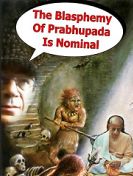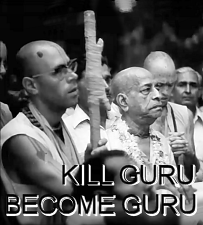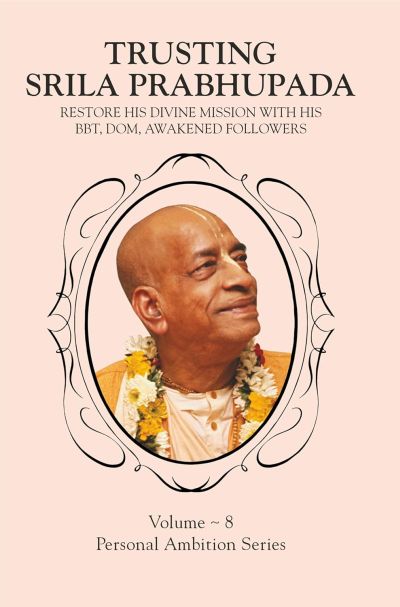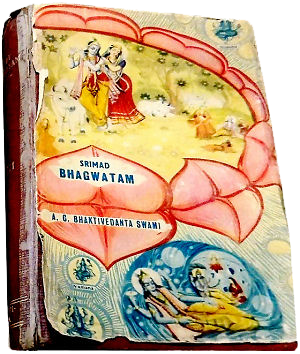By Niscala Dasi
November 12, 2011 — For those who already believe in God, the question of doubt in His existence may seem irrelevant, even a burden. If one believes he has already passed the test of faith, then why go backwards?
Such an attitude cannot be real faith that is the foundation of devotion, for it is devoid of two essential religious principles- humility and the quest for truth. The opposite of humility is pride, a fact we may all agree upon, but what may be contended is- the opposite of truth is assumption. How it is so, is as follows…
The opposite or antonym of “truth” is not “falsity” as is commonly interpreted, for “falsity” implies having knowledge that something is false. Falsity is a better antonym for inanimate objects, like currency. When we speak of someone being false, a pretender, again we are looking at an object- that person.
Subjectively, however, from the pretender’s point of view, he is simply assuming that he is something he is not- he believes his farce… If he does not believe his farce, and knows that he is false and simply pulling the wool over other’s eyes, there is an element of truth in his mind- he is not totally deluded.
Thus, assumption is the true antonym of truth, and truth seekers, known as philosophers, “lovers of wisdom- or penetrating truth”, from Aristotle to the present day Srila Prabhupada, have spurred on their disciples to see and to separate their assumptions.
Assumptions about Self
Assuming that one is beyond doubt is thus a delusion, and devoid of the quest for truth. It goes without saying that it is also devoid of humility. Sri Chaitanya advised, through His practical example, the disciple to consider himself a fool before the spiritual teacher. If one truly believes that all his knowledge may only be assumptions, then he will be fertile territory for the process of illusion stripping.
Assuming that one is ready for raganuga bhakti is another assumption which is against the religious principles of humility and the quest for truth. One may think one has outgrown vaidhi bhakti and is now ready for instruction from the “Mahabhagavat rasika vaisnava”. How can one be sure that this is prideful assumption, and not, as they claim, “laulyam”- transcendental eagerness?
True “laulyam” can be seen in the gopis who were eager to see the Lord, despite the ensuing condemnation from their relatives. It is an eagerness that is devoid of pride and egotistical analysis of one’s qualifications. A true devotee never thinks himself advanced at all, but aspires to serve the least significant of the Lord’s devotees.
Madhavendra Puri shunned honour- because he truly believed he did not deserve it. In vaisnava varnashrama, the sudra is in the most advantageous position- as he serves and respects everyone else and does not expect respect in return. This is exactly the mood of Sri Chaitanya in the Siksastakam.
What to speak of aspiring to be a sudra, who may be respected by at least his family members, He aspired to be a tree or a blade of grass, never getting any recognition, honour or reward for service rendered to humanity- with the greatest of difficulty.
If we want to know about raganuga bhakti, we have to follow in the footsteps of those that have it in the greatest and purest proportions- Srimati Radharani. It is described that She never wanted to enjoy Krishna Herself- but bring others to Him- let them take advantage. Internalized in the body of Sri Chaitanya, She preached with logic, reason, love, humility and compassion.
Thus, those who give up the internal mood of Radharani, who give up what She does and, thus condemned, cease to follow in Her divine footprints, in the Vraja dust of the preaching field, for the sake of their own advancement or enjoyment, thinking that is a step forward into raganuga bhakti, have replaced truth with assumption. One does not develop internally by ignoring the plight of the ignorant. The lives of all the great saints and mystics are attestations to this truth. At a certain level of realization, there is no difference between outer and inner, between selling books and pushing souls towards Krishna’s pastimes.
Hearing about the gopi’s qualities is the beginning of following in their footsteps by preaching- so those who give up preaching, for gopi katha, are following the process backwards. The illusion is they are going forwards, and because this is based on assumption, it is the antithesis of the quest for truth.
The upshot? Sure, go ahead and hear about Radharani, but then join the sankirtan party- not for glory, not for honour, but to do the work of Radharani in this world.
Assumptions about the Philosophy
Such sankirtan preaching, to be effective, must be itself free from dogma and assumption of all kinds. We cannot preach that Krishna consciousness is non-sectarian and act as if it isn’t. I have recently been going to Church, after chanting my rounds to pictures of the Diety, as we do not live near any temple. I realized that Jagannatha, Baladeva and Subhadra are actually Father, Son and Holy Spirit.
Baladeva is Jagannatha’s expansion, His Son, manifested in this world through the many spiritual masters such as Jesus Christ, who interestingly said that He is seated at the right hand of the Father- Balarama’s position. Subhadra devi is His Divine potency, which touches people, opens their hearts and enlightens them, as the Holy Spirit touched the disciples of Jesus.
Through the feminine mercy counterpart of God, known as Radharani, Subhadra, etc and the masculine knowledge counterpart of God, Baladeva, the original guru, one approaches God the Father. It is described in Chaitanya Caritamrita that all these aspects of God are one with Him- being different aspects of His potency.
If we view these religions as different, then we lose touch with these essential truths and our preaching becomes dogmatic and sectarian. Then those who are attracted by the non-sectarian message, leave us when they join, or soon after. Hence, we have few members.
This is not due to the lack of people attracted to sectarianism, for sectarian movements flourish- their message is in sync with their dynamic and so people who join them are not disappointed. If we don’t want people to “bloop” then whatever we preach, we must actually realize and embody in all our dealings, or we will be seen as hypocrites and dogmatic fundamentalists.
If we preach the need to protect women and the elderly, we actually have to give them facility in our temples and ashramas, not demand rent from elderly devotees who have surrendered lives and careers to serve the Lord and are the very meaning of “akincana”.
If we encourage our flock, at Sunday feast time, to see beyond external designations, we must do the same ourselves, and not assume that a sannyasi is more renounced than an elderly lady devotee seeking shelter, or an invalid devotee, wanting to be seen as something more than a burden.
It is inconceivable that a sick sannyasi in our movement would not be given the best medical treatment, or an incapacitated one, the best service, even though the ashrama of sannyasa confers a responsibility to be utterly dependent on God alone. But that is just so much rhetoric, as is the “protection of women, the elderly and the sick”, empty rhetoric. In practice, we pamper our sannyasis and neglect those most vulnerable, needy and surrendered.
This antithesis of vedic vaisnava society is all based on assumption- assumption about who is advanced and who is not. And it is also based on the assumption that a symptom of advancement, like in a corporation, is to be seen rubbing shoulders with the advanced, or at least licking some shoes.
This is interpreted as “getting some sadhu sanga”- the sadhu being not a person who is thoroughly honest and exposes all ones delusions and assumptions- but someone wearing orange- without a fold at the back, and a nice big stick- and who speaks real sweet, and says “Praapada” at regular intervals.
A person who has read Bhagavad gita for a while, and been inspired by its penetrating vision of the divinity in all, and the symptoms of true spirituality, could not bear this superficially designative behaviour so common in our temples, and one who is inclined to superficially designative vision, sectarianism, is not inclined to read the gita for very long- and become a devotee. Hence, we have very few members, apart from those born into it, our Indian community. It was not something intended, it just kind of crept up on us. Certainly, in Srila Prabhupada’s time, obeisances were paid to everyone, and he taught us to use the word “prabhu” to each other (even though the “prabhus” were hippies and drug addicts barely a week before!).
This actually means that everyone is my master, and I can learn from him, and should respect and serve him or her. If he or she is in need, it is mercy on me, to be given an opportunity to render him or her some important service. And as Srila Prabhupada sometimes exposed a desire for sannyasa as being simply a desire for honour- and discouraged the practice by warning “no more sannyasa!”- we should do so too.
It is obvious, but it still needs pointing out, that in regard to the question of offering shelter, service and facility, that we should not ask “why?” to those to whom we have foresworn the same- as taught in our books, but to those whom our books teach, naturally shun shelter, except that of the feet of Bhakta vatsala. It is our responsibility to shelter the needy. It is the sannyasi’s responsibility to shun shelter, and be without needs.
Let things be, as they were intended. Let sannyasis look to Krishna to protect them in all circumstances, not caring for their bodily condition, and be reticent about accepting service and facility, limiting it to the absolute minimum to keep body and soul together (I wonder if this were pushed in ISKCON would we have such a queueing for sannyasa, still?
It’s a doubt worth testing.) And let all those who have rendered service to the Lord, be our masters and let us render them all service, especially if they inhabit the bodies of the most vulnerable- women, children, the sick, etc.
This is our legacy, given in the books, and if we are actually free from doubt, we won’t hesitate to take it up, as Arjuna took up his weapons, the instant he was free from doubt. The fact is, we actually have doubts, many of them, but we are too lazy to face them, analyse them and dispose of them.
Doubts are sometimes described as demons, but when Krishna came, He fought with demons. He did not ignore them. Even when the demons in Krishna’s pastimes dressed themselves up as something different, an innocent calf, a cowherd boy, or a loving mother, He identified the essential difference, tackled the imposter and defeated him.
We have to do the same with doubts, they are dressing up as something innocent in our subconscious, and there they blend in with the devotional crowd, having adopted the attire. Then we do not see them-and we assume we are free from doubt. From one assumption, another comes, then another, much as when we assume one plus one equals three, we mess up all our calculations…
We assume that the desire to associate with a sannyasi is the desire for sadhu sanga, though the sannyasi has only ever glorified us and pampered to our assumptions, exposing none.
We tell the devotee who has never pursued a career, has given up such pursuits for Krishna, and is unprotected in old age or invalidity, “Krishna will protect you!” admiring ourselves for such faith and lack of sentimentality, which is hard-heartedness and irreligion, disguised. We think that demanding rent from such devotees is using money for only for Krishna, ignoring the edict “I am only served through My devotees”, assuming that He could only be referring to someone in orange, sporting a danda.
When we have external vision, we assume a lot of things, just as a person, defective in vision, assumes a rope to be a snake, and vice versa.
If a person knows his vision is defective, he is not in danger- as his assumptions can be exposed by another who sees more clearly. This is the disciple- and this is why humility in the disciple is necessary- real humility, not the kind of self-inflating hyperbolic pretense that gives us to proclaiming it in all its glories, “I am so fallen, I am such a wretch, etc etc”, but a realistic assessment that
1. There is every possibility that everything I believe in as true could be an assumption.
2. There is every possibility that my understanding of vedic truth is shallow, dogmatic and riddled with unseen doubt.
3. That being so, I need to be open to truth, from whomsoever it may issue.
Such a realistic analysis is conducive to the quest for truth, it leaves us open. Other reality checks can leave us open at another layer- that of the heart- and are conducive to humility, gratitude and love. We need to be open-minded and open-hearted as well…
4. It is a fact that I am utterly dependent on others, not just for physical and emotional survival, but spiritual survival as well. Krishna only accepts service through the servant of the servant (etc, etc.) of His devotees. Without opportunities for serving the least of His devotees, not the great ones that serve Him directly, but the tiny unnoticed and oft-neglected ones- can I ever hope to attain the grace of Lord Govinda.
He is smaller than the smallest, so let me seek out the smallest, and serve them. He enters into the heart of an ant, and understands its pain and its needs. Let me do the same. I can enter into another’s heart through empathy, and do God-like work, qualifying for work in His eternal abode of loving exchanges, that take place between simple and unassuming cowherd girls, looked down upon as prostitutes and constantly receiving a barrage of insults from their so-called mothers-in-law.
5. Since I can only serve the Lord through His least devotees, I am at their mercy to give me opportunities for service. They appear very small, insignificant, and like a dwarf brahmana, begging for land, they appear to be in need of my assistance, but actually, I am in need of their assistance, as in opportunities to serve. The appearance is that Krishna, as a small child or a dwarf-brahmana, seems needy and vulnerable.
The reality is, those who have material facility, who have strength, stature, power and fortune, are actually the needy and vulnerable ones, much as a drowning person is more vulnerable, the more he is carrying… Krishna and His devotees come to appeal to our sense of generosity, compassion and justice, and in doing so, they free us from the shackles of wealth and possessiveness, as Lord Vamanadeva did, Maharaja Bali.
Real humility is based on truth, and the truth is we are all small and insignificant compared to the universe. The vedic truth is that love makes everyone significant- Krishna enters, out of love, into the heart of an ant, and empathizes with its pains, desires and needs. This makes the ant truly significant, and if we were to ever dissect one, we would be awed at the complexity of its biology, a subatomic miracle that goes on unnoticed everyday, while we look for bleeding statues…
Small things are indeed very miraculous, as are acts which go unnoticed and unglorified…. simple acts of loving kindness, that are touchstones to the heart. Doubts can be eradicated by direct experience, and when the sastra describes melting of the heart and one experiences it personally, one eradicates any lingering doubt, at its source. By inner and outer experience, one gradually dispels ones doubts, provided that one has not assumed one is free from them.
Going even further, we challenge our doubts that God may be present in His Holy Name. How do we know that? How can a form and a word be the same? We can say “because that is the nature of absolute non-duality”, which is a good answer, because it proves the fact by word analysis- but how do we know such non-duality exists?
It is one thing to say “a science professor knows science- by definition of what science professor is”- because we have known science professors personally. We do not know non-duality- everything in this world has its dual opposite.
Darkness and light, up and down, here and there, in general, this and not that- form but not name, name but not form. How are we to accept the existence of non-duality, other than by blind belief, by dogma?
The only way around this is to actually experience God’s name and form to be the same, which takes a certain amount of purity, for such perception requires qualification. But as I mentioned before, there is inner and outer perception. If God is everywhere and there is nothing that is not God, then it follows that this world should be composed of God’s name, and upon analysis, it is so.
That everything is comprised of vibration is actually the last word in physical science thus far, and proves the existence of non-duality in this world. This “string theory”, which seems to explain all the different ways that matter behaves, and combines the various laws into a single paradigm, shows how form exists only of vibration and vibration is form. Different forms arise due to different vibrations, and only our lack of vision causes us to believe differently, and see them separately.
If God is omnipresent, then quantum physics proves the non-duality of God, and that being so, He is His name. We can thrill in this fact, knowing it to be true, and belief playing no part whatsoever. As Karl Jung once declared, being overwhelmed by facts: “I don’t believe in God. I know there is God”, knowledge dispels doubts, while faith or belief casts them into subtle forms which sap our vigour.
Better to face those subtle forms, which are demons in devotional attire, wrestle them in the arena of consciousness and dispense them off to the nebulous realm of non-science, where they belong.







Nah, “false” is actually the more accurate antonym of “true.” If something is not true, it is false. If something is not false, it is true. Regardless of knowledge or belief surrounding it.
“Assumption” has no bearing on the quality of truthfulness / falsity of something, nor even necessarily on belief surrounding that something. An assumption is just a tool for deriving logical conclusions about something based on the “assumed” truthfulness or falsity of a statement. The content of an assumption may, in reality, be true or false; the assumption does not care about that. As a rhetoric tool, one may even make an assumption she does not believe for the purpose of contradiction. (Of course, people do often tend to base their beliefs upon assumptions without full knowledge, which is why, of course, we choose to follow the descending process of knowledge development.)
Therefore “assumption” is not an appropriate antonym for “truth.”
Peace, one.
Pamho! All glories to Srila Prabhupada!
Thank you for a lovely article! There is a lot in it to take it! Well written and thought out.
Such an article needs to be re-read and notes taken from it and many points should be taken to heart.
Thank you for rendering this wonderful service to us. :)…hope I can serve you someday too in some insignificant way.
Thank you.
ys Suvarna